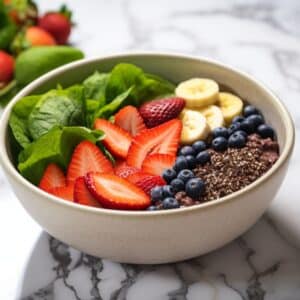The chocolate in this diabetes-friendly recipe adds a treat-like flavor to this easy dish that can be eaten morning, noon and night.

Indulge in the captivating flavors of Fresh Fruit with Chocolate Quinoa, a delightful recipe brought to you by Mastering Diabetes. This exquisite dish seamlessly blends the goodness of fresh fruits with the earthy allure of chocolate quinoa, offering a treat that not only satisfies your taste buds but also supports your journey towards better health.
Embrace the harmonious combination of nutrient-rich ingredients that satiate sweet cravings while nourishing your body from within.

Quinoa: The Mighty Superfood for Diabetes - Nourishing Health, Taming Blood Glucose Levels
Quinoa (Chenopodium quinoa) is a grain-like crop that has been cultivated in the Andean region of South America for thousands of years. It was a staple food of the Inca civilization and was considered sacred by the indigenous people of the Andes. Quinoa's resilience, adaptability, and high nutritional value allowed it to thrive in the harsh Andean climates, contributing to its significance in their culture.
In recent decades, quinoa gained popularity worldwide as a nutritious and gluten-free alternative to traditional grains. Its rise in popularity as a healthful superfood has led to increased cultivation in various regions beyond the Andes, making it readily available in markets and stores worldwide. Today, quinoa continues to be celebrated for its exceptional nutritional content and versatility in various culinary creations.
Quinoa is often hailed as a superfood due to its impressive nutritional profile. It is a complete protein source, meaning it contains all nine essential amino acids necessary for human health.
A cooked 1-cup (185 grams) serving of quinoa provides approximately:
Calories: 222
Carbohydrates: 39 grams
Protein: 8 grams
Fat: 3.5 grams
Fiber: 5.2 grams
Magnesium: 30% of the Recommended Daily Intake (RDI)
Phosphorus: 28% of the RDI
Folate: 19% of the RDI
Iron: 15% of the RDI
Zinc: 13% of the RDI
Vitamin B6: 11% of the RDI
Potassium: 9% of the RDI
Niacin (Vitamin B3): 8% of the RDI
Quinoa has a relatively low glycemic index, which means it does not cause rapid spikes in blood glucose levels after consumption. The GI of quinoa is around 53, making it a favorable choice for people with diabetes or those looking to manage their blood glucose levels.
The glycemic load (GL) takes into account the portion size of a food and its effect on blood glucose. Quinoa has a low GL, further indicating its potential to help stabilize blood glucose levels when incorporated into meals.
Quinoa is an excellent option for people living with diabetes due to its low glycemic index and high fiber content. The combination of protein, fiber, and slow-releasing carbohydrates in quinoa helps promote steady blood glucose levels, preventing rapid spikes and crashes. Moreover, quinoa's impressive nutrient profile supports overall health, making it a valuable addition to a diabetes-friendly diet.

Berry Bliss: Sweet Delights for Diabetes
Berries are nutritional powerhouses, packed with vitamins, minerals, antioxidants, and fiber. Let's look at the nutritional content of strawberries, blueberries, and raspberries per 1-cup serving (approximately 150 grams):
Strawberries:
Calories: 49
Carbohydrates: 11 grams
Fiber: 3 grams
Vitamin C: 89% of the Recommended Daily Intake (RDI)
Manganese: 29% of the RDI
Folate: 9% of the RDI
Potassium: 6% of the RDI
Blueberries:
Calories: 84
Carbohydrates: 21 grams
Fiber: 4 grams
Vitamin C: 24% of the RDI
Vitamin K: 36% of the RDI
Antioxidants (Anthocyanins): Blueberries are especially rich in various antioxidants.
Raspberries:
Calories: 64
Carbohydrates: 15 grams
Fiber: 8 grams
Vitamin C: 54% of the RDI
Vitamin K: 12% of the RDI
Manganese: 41% of the RDI
Berries, including strawberries, blueberries, and raspberries, generally have a low glycemic index, typically ranging from 25 to 40. The low GI means they cause only a gradual increase in blood glucose levels when consumed.
The glycemic load (GL) of berries is also low because of their relatively low carbohydrate content. A low GL indicates that berries have a minimal impact on blood glucose levels, making them suitable for people with diabetes.

Fruitful Fuel for Diabetes
Fruit can be incredibly beneficial for people living with diabetes, especially when they prioritize keeping their fat levels low. Unlike some misconceptions, fruits are rich in essential vitamins, minerals, fiber, and antioxidants, making them a nutritious addition to a diabetes-friendly diet.
When consumed in their whole, unprocessed form, fruits typically have a low glycemic index, meaning they have a minimal impact on blood glucose levels. Moreover, the natural sugars in fruits are accompanied by fiber, which slows down glucose absorption, helping to maintain stable blood glucose levels.
By focusing on low-fat fruit choices, individuals with diabetes can enjoy the healthful benefits of nature's gifts without compromising their blood glucose control, supporting their overall well-being in the journey towards managing diabetes effectively.
Berries, with their low glycemic index and glycemic load, are excellent choices for people living with diabetes. They provide a natural sweetness while helping to maintain stable blood glucose levels. Additionally, the fiber content in berries slows down the absorption of glucose, further contributing to better blood glucose management.
The vitamins, minerals, and antioxidants in strawberries, blueberries, and raspberries offer various health benefits, including supporting heart health, reducing inflammation, and enhancing immune function. Including a variety of berries in the diet can contribute to overall well-being and support diabetes management.


Fresh Fruit with Chocolate Quinoa
Ingredients
- 1 cup cooked quinoa
- 1 tbsp cacao powder
- 1 cup mixed spring greens
- 1/2 banana - sliced
- 1/2 mango - sliced
- 1/4 cup blueberries
- 1/4 cup raspberries
- 1/2 cup strawberries - cut in half
- 1/2 tbsp maple syrup - optional
Instructions
- Stir the cacao powder into the cooked quinoa and mix well.
- On a plate spread out the mixed greens and top with chocolate quinoa.
- Add the fruit and top with maple syrup if using.

